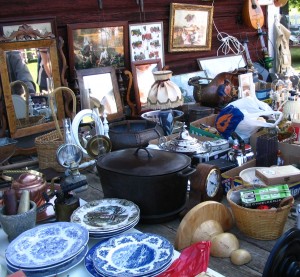Trash or treasure?
 On almost any given night of channel-surfing, viewers can tune into one of a dozen or so reality television shows about people who make their living finding treasures in trash. Whether bidding on storage lockers, bargaining with antique collectors, or haggling for the best deal at a pawn shop, junk-hunting television shows feature larger-than-life characters motivated by finding treasure and making a significant profit.
On almost any given night of channel-surfing, viewers can tune into one of a dozen or so reality television shows about people who make their living finding treasures in trash. Whether bidding on storage lockers, bargaining with antique collectors, or haggling for the best deal at a pawn shop, junk-hunting television shows feature larger-than-life characters motivated by finding treasure and making a significant profit.
“The allure of finding treasure in trash is something a lot of people get excited about,” says Randy Brown ’05, a fan of “American Pickers,” a History channel show that follows “picker” partners Mike and Frank as they travel the American countryside looking for old, unique pieces to sell in their two Midwestern shops. Brown says, it’s easy to sit in your living room and think anyone can do what these guys do, “but it takes a lot of hard work, knowledge and luck to be successful.”
Maris Miller `08 knows firsthand about the hard work involved in the re-selling of other people’s goods. Miller’s father has been an auctioneer in eastern Pennsylvania for nearly 20 years. “Some shows glamorize auctions, but in reality the auction business is time consuming, demanding and labor intensive,” she says, “The auctioneer often works closely with people who are experiencing transitions related to things such as aging, divorce or death.”
The long hours, back-breaking work and literal piles of trash don’t seem to discourage junk-hunting stars though. Rather, they (and the viewers who tune in week after week) seem highly motivated by their quest to find value—monetary, nostalgic, artist or otherwise—in the most unsuspecting places.
One person’s trash is another person’s treasure
So, what is motivating Americans’ renewed interest in old, sometimes discarded, items?
Craig Dalen, director of sustainability at Messiah, notes that today’s goods are not meant to be repaired but rather thrown away and replaced. “I think these ‘picker’ shows touch on something nostalgic about the kinds of goods we used to own and how they were built,” he adds. “The stuff is like a cultural artifact.”
Certainly part of the appeal of junk-hunting television shows is the possibility of seeing an item from your own childhood. Rachel (Harvey) Roth `05 and her husband are fans of one of the newer shows, “Toy Hunter.” “We loved this instantly,” she writes, “because it reminded us of our childhood. It reminds us of a time when entertainment came from our imaginations instead of technology.”
The historical aspect of these shows is also certainly compelling. “Each piece brings its own unique slice of Americana,” adds Roth.
Often the discovered items hold more than just nostalgic worth—they also hold monetary value, sometimes significant monetary value. Miller recalls her auctioneer father and mother sorting through a dilapidated shed and cottage in Berks County, Pennsylvania, to prepare for an auction. First, they discovered that the owner of the property had been married to American natural stone sculptor John B. Flannagan. No one knew the deceased woman had been married to the renowned artist. Then, they made a huge discovery: several original sculptures, including one that had been featured on the cover of a Museum of Modern Art magazine in the 1940s. The piece sold at an auction for $35,000.
Of course not every moment of searching for treasure is glamorous. In addition to stories of great, valuable finds, Maris also recounts an experience of sorting through a vacant, condemned home with no electricity that was literally falling down around them while they sorted items covered in filth.
The appeal of the “pick”
Not every “pick” results in a treasure. That’s what Matthew Peregoy `05 cites as his reason for enjoying shows like “Antique Roadshow” and “Market Warriors.” He explains, “I enjoy seeing the things that people place value on, seeing how they react to a good find and how they still love a piece even when they find out its worthless.”
While value and profit are certainly primary motivators for the pickers, junk hunters, and pawn shop owners on television, most American who thrift, antique and yard sale, do so to save money, to live a more environmentally sustainable life or because the pick simply resonates with their personal history or sense of style.
David Kasparek, associate professor of graphic design at Messiah, is a fan of “American Pickers” and “Pawn Stars.” He notes, “Many of these artifacts affect collectors in a similar way: they possess a specific visual language that points to a time and place in our lives that reinforce a sense of place or home.”
These uncovered artifacts also have a striking visual aesthetic that makes them appealing. Old metal signs, for example, are dynamic, bold and possess visual evidence (rust, dirt) of the passing of time. They tell a story and can carry significant personal attachment to the product or service being advertised, adds Kasparek.
In addition, the proliferation of Pinterest and other similar inspiration-based websites empower many people to repurpose old items into something new and functional. And, whether those who repurpose items are intentionally trying to be sustainable or not, the result is favorable to the environment. Dalen, sustainability director explains, “Any time we can extend the usable life of a good I think it can contribute to a more sustainable lifestyle. You’re reducing the demand to produce more and more and, in an indirect sense you’re helping to conserve energy.”
Whatever their motivation—environmentalism, profit, history-telling, artistic value, nostalgia—it’s safe to say that many Americans find the uncovered treasures to be the true stars of these popular television shows.




